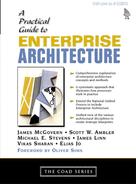Chapter 9. Presentation Tier Architecture
Computers are useless. They can only give you answers.
—Pablo Picasso (1881–1973)
Presentation tier is where the users and the system meet each other. This tier is responsible for generating the user interface (UI) for the users of the system. Presentation tier architecture is the act of defining the blueprint or the underlying schematics used to map out or design a system. Since UI is the most visible part of the system, it ends up being the most frequently changed part. This is perhaps the main reason for separating the presentation tier from the other back-end code in multi-tiered software architecture.
The basic concept of a tiered architecture involves breaking up an application into logical chunks, or tiers, each of which is assigned general or specific roles. Tiers can be located on different machines or on the same machine where they are virtually or conceptually separate from one another. The more tiers used, the more specific each tier's role. Multi-tier architecture concepts are fast evolving, whereas in most architecture a clear separation exists between the front end that contains the code for generating the UI and the back end that contains the code for business logic and the databases.
In this chapter we will discuss some of the following:
Business needs and presentation requirements
Key presentation tier components
General design considerations
Key architectural considerations
